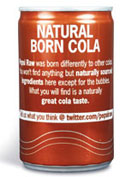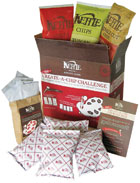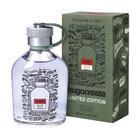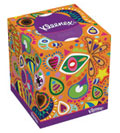Incorporating social media and other technologies into brand communications is a standard part of consumer marketing today, with such tools successfully being used to create closer connections with consumers and to provide platforms for literate users’ self expression. However, one aspect of the phenomenon that hasn’t been thoroughly explored and developed is the integration of social media into packaging design. But savvy brands are waking up to the power and potential, launching innovative initiatives that engage consumers like never before.

Design: GraphicoDMG

Vitaminwater also ran a Facebook campaign to elicit consumers’ tastes for the launch of Vitaminwater Connect, a black cherry-lime flavor made with caffeine, launching in March with a label that reads “Made by fans, for fans of Facebook.” The campaign, which required users to download an application on the brand’s Facebook page, began by asking consumers to pick their favorite flavors. A series of quizzes and games determined which nutrients users needed most, and which of these would be included in the new flavor. In the final stage of the promotion, Facebook users designed a label for the new Vitaminwater using the brand’s so-called “flavorcreator” application; more than 116,000 unique users participated. And while that’s a significantly lower number than the 1 million fans on its Facebook page, the online buzz the promotion has generated across blogs and design-oriented sites more than compensates for the slower uptake.
While Pepsi and Vitaminwater’s initiatives were successful in driving traffic and buzz online and in extending the user experience, other brands are taking the level of consumer engagement a step further.

Design: Cubo
Building on the success of this effort, Doritos embedded social media applications into packaging design for the launch of its Sweet Chili flavor in Brazil. Here, the brand merged augmented reality (AR) with social networking to create a highly engaging campaign. Each packet of Sweet Chili Doritos crisps was printed with an augmented reality symbol, which could be activated on the brand’s website by positioning the bag in front of a webcam. The site used AR technology to identify the code on the bag and, thereafter, to display “Doritos Lover” animated monster characters in a way that appeared as if they were sitting on the user’s bag.
To add a level of exclusivity, each participant was allocated their own unique character, which could be displayed within their personal profile on Orkut, Brazil’s largest social networking site. Users could create a birth certificate for their character and take pictures with it to be posted on the Doritos site, where the character could also interact, hug and even fight with other “Lovers” at random. With over 23,000 Doritos Lovers characters successfully released within the first week of the campaign’s launch, the initiative was a triumph. Not only because it brought the packaging to life by giving it a quirky personality, but also because it simultaneously propelled the product into social networking spheres in a way that strengthened the brand proposition and reached widespread audiences.
In fact, Doritos has become a pioneer of innovative packaging solutions, as witnessed by the brand’s latest development, which truly raises the bar in terms of packaging innovation and value. To create buzz around its Doritos Late Night snack-launched by PepsiCo’s Frito-Lay division-Doritos released a number of specially marked bags that served as “tickets” to access a virtual concert of 3D performances by rock bands Big Boi and blink-182. After logging on atwww.doritoslatenight.com, fans pointed the special symbol on the back of Doritos Late Night special-edition bags at a webcam to launch virtual performances by the bands that appeared to pop directly out of the bag. Fans could also personalize each performance by the way they held, moved and shook the bag, offering a new experience every time.
This online offering is the latest evolution of the Doritos brand, allowing consumers to curate and control the experience. It also demonstrates how packaging-if linked to sophisticated digital components-can deliver music and other cultural content and, in this case, act as the glue that holds an entire campaign together.
Of course, Doritos isn’t the only brand to be harnessing AR technology. To celebrate its 25th anniversary, pizza chain Papa John’s launched a smart initiative that used AR to release exclusive coupons to consumers who participated in the experience. For a period of time, the undersides of the brand’s pizza boxes were printed with an AR symbol – which, when held up to a webcam while logged onto the brand’s microsite, took the participant on a virtual drive along a highway. The further users progressed, the more coupons they collected, enabling the brand to reward loyal customers and boost traffic to its website, which was visited over 200,000 times in the first two weeks of the campaign’s launch.
Such technologies can also add genuine value to the shopper experience, as seen in Lego’s AR-enhanced digital point-of-sale display. Integrated with a camera and augmented reality software, the brand’s POS unit combines real-world and computer-generated imaging. For instance, when a customer holds up one of the RFID-enabled Lego products, such as the brand’s hydraulic digger or police station, the unit’s software is able to recognize the item inside the box and display it in fully assembled form as a 3D animated image. The 3D form appears to be situated on top of the box, and allows the toy to be viewed from all angles. Currently being tested in select toyshops and Lego stores worldwide, the AR display demonstrates how intelligent packaging can aid consumer purchasing decisions by triggering the imaginations of children and adults alike.
Another popular way of providing consumers with useful information is through the use of QR codes and 2D barcodes that direct users to dedicated microsites. In the UK, Marks & Spencer recently trialed on-pack DataMatrix (2D) barcodes on 300mL juice bottles. When scanned with a mobile phone camera, shoppers were directed to the retailer’s Food To Go mobile site featuring a range of content-including product information and a joke of the day-along with a voucher code to claim against their next bottle of freshly squeezed juice.
Similarly, Pepsi Max recently used QR codes on cans and bottles in the UK to drive users to a mobile-phone-accessible site, offering users the chance to “get new kicks every day” with tips from life coach Rusty Champion, along with free games and product information.

Design: Heineken
More recently, the idea was further developed by Amsterdam-based beer brand Heineken with its online customization service that enables customers to design and order personalized beer bottles. Users can take a blank bottle and choose from a selection of backgrounds, colors, shapes and text or customize one of 80 existing designs. Finished designs can be viewed in 3D and saved to the user’s profile or emailed to friends, while exceptional creations may be selected by Heineken for display in the online gallery (found on the websitewww.jouwheineken.nl). Once ordered, the design is printed onto foil labels and applied to the bottles, which are produced in packs of six for $22.30 (15.95 Euro). The packs can be collected from the Heineken the City concept store in Amsterdam or delivered to any address within the Netherlands.
Further outstanding innovation in packaging and product development is shown by beer brand Fosters, which garnered feedback for a new beer variety from 1,000 “creative” drinkers. The beer was launched in plain, unbranded bottles at music, art and fashion events where guests could use postcards to note feedback about the taste, choose a name and propose ideas for the bottle design. Chilled bottles were couriered to creative thought leaders, who could also submit their views by postcard or on the Fosters website.
The name Nelson-inspired by the New Zealand region from which ingredients were sourced-was a popular choice with tasters, who also suggested that the label should change periodically to feature graphics by different artists and designers. The beer is now available in select bars across Melbourne and Sydney and is a good example of how “crowdsourcing” creative content (through online and physical portals) can create a strong, sticky brand proposition. The ongoing modification of the bottle’s graphic will appeal to collectors and keep fans engaged.
Similarly, provoking ongoing conversation with consumers is the focus of the new packaging-focused campaign from South African restaurant chain Nando’s. Provocative questions like “What do you see in the clouds?” and “What do you get up to when no one is looking?” have been printed onto the packaging sleeves and wrappings, to inspire conversation every time Nando’s fare is enjoyed. As an extension of the process, the dialogue is continued with the development of a website platform that consumers are encouraged to visit. The eatery’s Yourchirp.com site enables consumers to chirp their answers to life’s big questions or to post questions of their own, rendering it possible for the brand to continuously connect with their customers, and for consumers to connect with the brand.

Design: Groove 11

Design: RockandRoll Agency

Design: Mass Hispanic
With all these examples, it is clear that technology-integrated packaging has the potential to fluidly link the physical, digital and virtual worlds of consumer brands. By fusing packaging design with social media and emerging technologies, the medium can be made ever more compelling, to capture new audiences, and if well-executed, to be the glue that seamlessly holds an entire campaign together.
Leading brands need to consider how far their packaging solutions can be pushed, as rapid digital developments mean that highly imaginative, boundary-smashing solutions are well within reach.
Mandy Saven is editor of the Global Innovation Reports published by GDR Creative Intelligence, a London-based trend analysis consultancy specializing in retail, leisure and hospitality design. Contact Mandy by email at mandy@gdruk.com, or on Twitter at @mandysaven or @GDRUK.
